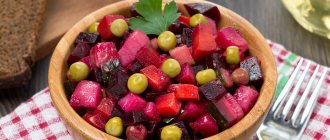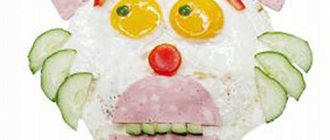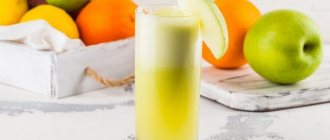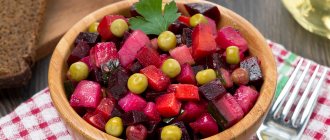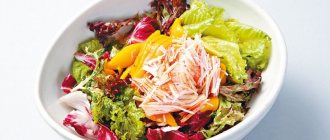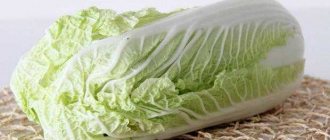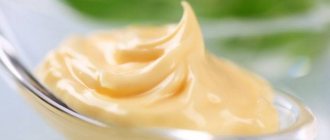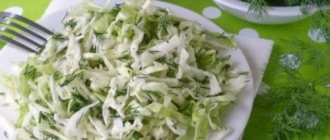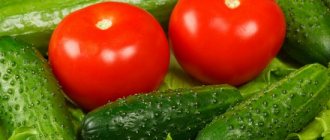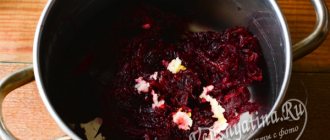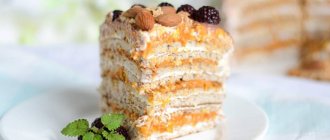What can I add?
There is no generally accepted recipe for vinaigrette, but there is a list of basic ingredients. An important point: beets are always present. Added to the classic set of products:
- mushrooms;
- boiled fish;
- lingonberries;
- chopped herring;
- boiled and smoked seafood;
- green peas (preferably boiled);
- beans;
- boiled meat or tongue;
- “Antonovka” apples (fresh or soaked);
- fresh tomatoes;
- fresh herbs;
- green onions.
If meat or fish is added, cabbage is excluded. Novice housewives need to remember this nuance so as not to spoil the holiday dish.
Tips for making a healthy salad
Expectant mothers are faced with various deviations in well-being, as a result of which there is a need to carefully think through the menu. When planning a pregnant woman’s diet in the second half of pregnancy, just as in all other cases, you need to take care of the proper preparation of your favorite dishes.
Vinaigrette does not have a generally accepted recipe. Despite this, it is important to focus on the basic ingredients. In this case, beets are required. Mushrooms, boiled fish, herring, a variety of seafood, lingonberries, meat, beans, green peas, apples, and tomatoes are traditionally added to the classic set of products.
Any available vinaigrette for pregnant women contains a large number of nutritional components and valuable vitamins that support the female body and the proper development of the unborn child.
Adding high-calorie mayonnaise, smoked fish, herring or meat with a high level of herring and nuts is undesirable. Otherwise, the dish will no longer be low-calorie.
The benefits and harms of vinaigrette for the figure when losing weight
Vinaigrette is a salad of boiled and salted vegetables, seasoned with oil. Sometimes vinegar is added to it. The vinaigrette usually contains boiled beets, carrots and potatoes. These and other vegetables present in the dish are good for your figure because:
- Boiled beets are a root vegetable rich in fiber and dietary fiber. It perfectly cleanses the blood of toxins and helps remove toxins. In addition, beets help relieve constipation.
- Boiled carrots retain all the properties of a fresh root vegetable. It has a positive effect on digestion and enriches the body with vitamin A. Thanks to dietary fiber, boiled carrots “sweep out” putrefactive residues from the intestines and provide a mild laxative effect.
Read: Benefits and harms of cashews for men
- Boiled potatoes are good for your figure if they are boiled in their skins. However, given the starch content, it is better to limit the amount of potatoes in this dish.
- Green pea. Considering that canned peas contain added sugar, it is better to use frozen peas for the vinaigrette. This will reduce the overall calorie content of the salad.
- Onions are useful for weight loss because they promote the breakdown of fats, eliminate putrefactive processes in the gastrointestinal tract, and have a mild diuretic effect.
- Pickles and sauerkraut contain a lot of vitamin C, which has a positive effect on metabolism.
The vinaigrette is seasoned with vegetable oil, which helps absorb many vitamins and is itself a source of vitamin E, but is characterized by a high calorie content.
Vinaigrette causes harm in cases of intolerance to the components of the dish, diarrhea, and acute problems with the gastrointestinal tract.
“Night gluttons” are a terrible enemy for almost everyone who tries to adhere to a healthy diet. He doesn't let you fall asleep and drives you to the refrigerator in the dark. Alas, it is difficult to resist him, for many it is impossible. But you can give in and eat something not very harmful.
By the evening, food is processed in the body much worse than in the first half of the day, since all processes in our body slow down and it prepares for sleep. And you there - a cutlet, fatty, sizzling. What a gift! And it will not be digested properly and will settle almost entirely on the thighs.
But jokes are jokes, and in the evenings people also want to eat. And if you come home around 10 pm, after a busy day, then how can you not eat here. Of course, we need to have dinner. But not every dinner will be good shortly before going to bed.
There are several rules: firstly, dinner should not be the main meal of the day. If you can’t have a normal lunch, then shift the focus to breakfast. And dinner should be as light as possible, but at the same time noticeable.
Secondly, it is advisable to wait a little after eating and not immediately fall into bed. And third, consider avoiding eating close to bedtime. The best time for dinner is 3-4 hours before bedtime, and one hour before you can drink a glass of kefir or milk.
But remember that abruptly tearing yourself away from the refrigerator is not an option. You'll still fail. You can make your dinner as light and healthy as possible. For this, our 9 late-night snack ideas will come in handy.
Diet, menu for pregnant women
The menu of the expectant mother is exactly the factor that can radically affect the physical and mental health of the baby.
Therefore, the diet during pregnancy should be calculated from the perspective of its influence on the formation and development of the fetus. A pregnant woman needs to make adjustments to her diet. The uterus enlarges and begins to put pressure on the internal organs, including the stomach and intestines, so it is better for the expectant mother to eat little by little and more often. Replace daily three meals a day with 4-5 meals a day, and in the second half of pregnancy with 5-7 meals a day. Try to distribute foods between meals so that in the first half of the day you eat mainly fish, meat, and cereals. Leave dairy and plant products for the evening.
The last meal should be at least two hours before bedtime. When creating a menu for a pregnant woman, you should first of all be guided by other general dietary recommendations. Eliminate fatty, fried, smoked, spicy, salty, sour, pickled and canned foods from the diet - all this, one way or another, overloads the liver and gall bladder.
If you also study special literature, you may get the impression that you can’t eat practically anything, and only porridge and low-fat yogurt can live in a pregnant woman’s kitchen. However, it should be clearly remembered: there is no such product, a single use of which in moderate quantities could have a detrimental effect on the course of pregnancy or the condition of the fetus.
Of course, there is a group of foods and cooking methods that are best either completely excluded from the diet during pregnancy, or eaten occasionally, in minimal quantities. Thus, coffee and wine contribute to increased blood pressure, which is undesirable for the expectant mother. Beer and pickles increase the load on the kidneys, which during pregnancy already work for “two people”. In general, alcohol, especially in large quantities, can negatively affect the formation of the baby’s organs and systems.
In addition, it is advisable for expectant mothers who are prone to allergic reactions or who have close relatives with allergies to remove chocolate, citrus fruits, strawberries, exotic fruits, seafood, and nuts from their diet. What remains? You can and should include greens, vegetables and fruits, almost everything (excluding allergens) in a pregnant woman’s diet. They must be consumed raw or heat-treated. These are, as a rule, main courses and salads, which are best seasoned with unrefined vegetable oil.
Berries - cranberries, lingonberries, rose hips, blueberries, currants, chokeberries - are the main helpers of the expectant mother's kidneys and a source of vitamin C. The berries are good fresh, pureed with sugar, boiled, in the form of fruit drinks, compotes, jelly.
Porridge is an ideal breakfast for a pregnant woman. Buckwheat, millet, corn and oat porridge contain iron, carbohydrates, vitamins, and fiber. It is better to cook them in water, and add oil a few minutes before they are ready. You can add dried fruits to sweet porridges, and various sautéed vegetables to salty porridges.
Muesli is no less useful - a simple ready-made vitamin cocktail, and quite high in calories. Muesli can be eaten with fruit juice, milk, kefir, and yogurt. By the way, dairy products, both fresh and fermented milk, are the main source of calcium - you can’t do without them.
And meat serves as the main source of animal protein, B vitamins and iron. It is better to buy chilled meat rather than frozen, it retains its beneficial qualities better. For meat snacks, give preference to low-fat ham and boiled pork. But it is advisable to abstain from sausage products; they contain too much fat and preservatives.
Fish. This product contains vitamin D and phosphorus, which are responsible for the functioning of the child’s nervous system. Try to include fresh, low-fat fish in your diet (cod, perch, pollock, ice fish, hake).
Diet for pregnant women by trimester of pregnancy
In the first trimester, the body experiences adaptation to a new state. During this period, the fetus practically does not need to increase the calorie content of your diet. Moreover, the excess weight that you will struggle with in the postpartum period, as a rule, women gain in the first 12 weeks of pregnancy. Therefore, you should not listen to grandmothers who unanimously repeat: “Eat for two!”
In this trimester, all the baby’s systems are formed, and the main emphasis should be on the quality of food. The basis of the diet should be proteins and vitamins. Daily diet – no more than 2000 kcal. Do not limit yourself to fresh fruits, vegetables, herbs, juices. It is better to replace wheat bread with rye or bran bread. In the first weeks of pregnancy, protein accumulates in the mother’s body as a “building material” for the unborn child. Bones and tissues will begin to form later, but it is better to make a reserve now.
The second trimester is a time of active fetal growth. During this period, the mother’s body requires additional feeding: the daily ration increases to 2500 kcal. But this should not be done at the expense of sugar. Starting from 14 weeks of pregnancy, limit the consumption of confectionery, sweets, and jam to 40-50 g per day. The diet includes up to 40% fats of vegetable origin. They are part of the structure of all tissues and help the body absorb fat-soluble vitamins (A, F, K, D). From vegetable oils, choose any oil, consume up to 2 tablespoons per day. But it’s better to avoid animal fats (butter, cream, sour cream) for now.
In this trimester, the role of vitamins does not weaken. Thus, with a lack of vitamin D in a woman’s body, the fetus develops the bone skeleton worse, which increases the risk of rickets, and vitamin E affects bone growth. Vitamins “come” into our body with food. Vitamin B is contained in products made from wholemeal flour, bran, uncrushed cereals, legumes, potatoes, fruits, eggs, liver, meat, cottage cheese, and butter.
There is a lot of vitamin A in carrots, but it is absorbed only together with fats. Pour vegetable oil over the carrots, and your body will receive an additional portion of vitamin E. Calcium, from low-calorie foods, is most abundant in milk, low-fat cheese, and low-fat cottage cheese. Milk should be consumed separately from other foods and drunk in small sips - this way the calcium contained in it is better absorbed.
The benefits and harms of vinaigrette for pregnant women
Vinaigrette is prepared from natural products. All of them are a source of vitamins, minerals, organic acids that are beneficial for the expectant mother and child:
- beets are a source of vitamins A, C, group B, they are needed for proper hematopoiesis;
- carrots – contains a lot of vitamin A, good for the growth and development of the fetus;
- green peas – they contain vegetable protein, which is a building material for the developing fetus;
- potatoes are a source of potassium and other elements necessary for the proper functioning of the heart of the mother and unborn child;
Read: The benefits and harms of ghee
- onions – this vegetable contains a lot of vitamins and phytoncides, strengthens the immune system, protects against colds;
- sauerkraut and pickles - contain organic acids, vitamin C and microorganisms useful for digestion;
- vegetable oil is a source of vitamin E, which, in combination with vitamin A, regulates hormonal levels and prevents premature birth.
It is harmful for expectant mothers to eat vinaigrette if they have heartburn, flatulence, or diarrhea. Pickled cucumbers and sauerkraut in the dish can cause fluid retention and swelling. Although in small quantities this salad does not harm expectant mothers.
How to create a menu for a pregnant woman?
Vegetables and fruits must certainly be included in the daily diet of the expectant mother. If you don't have allergies, you can choose any of them. But it’s better to leave the exotic for later. It’s good if plant-based products make up 2/3 or at least half of your daily diet. Eat them raw and cooked, in salads, soups and main courses. Decoctions of dried fruits are very useful. Especially increase the amount of plant foods in the last weeks of the term. Vegetables and greens improve the elasticity of the tissues of the birth canal and help normalize intestinal function. In addition, extra pounds before childbirth are very undesirable, and such food will help maintain weight.
Berries are extremely healthy and desirable for a pregnant woman. You can and should eat a wide variety of berries. Prepare fruit drinks, compotes, souffles, eat fresh, frozen, dry, grated with sugar or in combination with other dishes (for example, in salads).
Meat should not be excluded from the diet under any circumstances. This is the main source of much-needed animal protein (along with fish and dairy products). Meat provides you with B vitamins and iron. Choose lean, chilled (rather than frozen) meat. But it is better to refrain from sausages with preservatives and dyes.
Fish is a source of phosphorus and vitamin D, which, by the way, are responsible for the functioning of the baby’s nervous system. Choose low-fat fish: cod, perch, pike, pollock, hake. And of course, it's better fresh. It is preferable to cook fish by boiling or baking.
Dairy products are the most complete and significant sources of calcium. Both fresh and fermented milk products are equally beneficial for a pregnant woman. A glass of kefir or yogurt will be an excellent option for a second dinner, and cottage cheese with sour cream for breakfast or an afternoon snack is not only healthy, but also tasty. However, be careful with whole milk - it contains a lot of allergenic protein. And any store-bought milk is whole milk. Therefore, it is better to drink it after boiling.
An old recipe for vinaigrette with herring
As you know, the very first vinaigrette was with herring and this salad came to us from the Scandinavian countries. But over time, herring was removed from the recipe because in those distant times, herring was hard to come by. And they left what was in abundance. That’s how this salad came to us without herring.
Today the problem with herring has been solved and why not prepare a vinaigrette in the original way, so to speak. Moreover, it is not so difficult.
You'll see how surprised your guests will be when they try an ordinary, familiar salad with a new ingredient.
- Fillet from one herring.
- 3-4 potatoes.
- 1 large beet.
- 2-3 carrots.
- 1 medium cucumber. (salty).
- 1 can 250 grams. peas
- Green onions and dill.
- Vegetable oil for dressing.
- Mustard for dressing.
- Black pepper and salt.
1. Naturally boil the vegetables and cool.
2.Chop vegetables and onions into small cubes.
6. Carrots, also in cubes.
7. Well, also diced herring fillet.
8.Place all chopped ingredients in a salad bowl.
9.In a small bowl, mix vegetable oil, mustard, black pepper and lemon juice. Mix lightly and season the salad. Taste for salt and add salt if necessary.
10. The herring vinaigrette is completely ready to serve and treat your guests to a bon appetit.
Chemical composition of vinaigrette
There are a lot of recipes for making vegetable salad. But the classic vinaigrette consists of the following products:
- potatoes;
- beets;
- carrots;
- cucumbers;
- onions and green peas;
- oils and salt.
The components of the cold snack provide it with a rather rich chemical composition.
The salad contains:
- B vitamins;
- nicotinic acid PP;
- vitamin K;
- ascorbic acid;
- cellulose;
- phosphorus and iron;
- beta-carotene;
- potassium and magnesium;
- calcium and iodine;
- starch.
In a classic vinaigrette, fats occupy about 10.3 g, while proteins and carbohydrates account for 1.7 and 8.2 g, respectively. 100 g of vegetable dish contains about 130 kcal.
The benefits and harms of vinaigrette for the figure when losing weight
A vinaigrette consisting of vegetables, peas and vegetable oil is a fairly light dish that can be included in the dinner menu. Eaten in moderation, this salad does not cause heaviness in the stomach.
Read: The benefits and harms of Brie cheese
Boiled and salted vegetables have a positive effect on the nervous system and help get rid of anxiety. The vegetable oil used to season the vinaigrette contains a lot of vitamin E, which is also useful for metabolic processes.
However, you should not eat vinaigrette immediately before bed. This is due to the fact that all the vegetables in its composition are rich in fiber and dietary fiber. This can cause flatulence and intestinal colic during sleep. And restless sleep does not add health to a person.
IT IS VERY INTERESTING!
- Why is it harmful to drink boiled water? Main reasons
- I want alcohol: what is missing in the body
- Why is it harmful to eat spicy foods? Main reasons
- Why is it harmful to eat chips? Main reasons
- Why is it harmful to eat potatoes? Main reasons
- How healthy is garlic? 6 amazing facts
- Why is it harmful to eat pork lard? Main reasons
- Why is it harmful to eat bread? Main reasons
Why is it useful?
Winter and spring are the best time for vinaigrette. Thanks to this dish, we can get the necessary nutrients from boiled vegetables grown in our region. The multi-component composition of Russian salad makes it the most healthy dish:
- Carotene from carrots protects the mucous membrane of the eyes;
- green pea glutamate supports mental activity;
- vegetable fiber prevents constipation and prevents heart attack;
- lactic acid in pickles protects against viruses;
- betaine from beets provides prevention of intestinal and liver cancer;
- beet flavonoids (vitamin P) help increase the elasticity and strength of vascular walls;
- beet pulp helps get rid of stomach ulcers;
- beets promote the renewal of liver cells and improve blood circulation;
- the low calorie content of the vinaigrette helps you avoid gaining extra pounds;
- vitamins contained in potatoes normalize high acidity;
- potatoes cooked in their jackets retain a significant portion of vitamin C;
- vegetables in the vinaigrette replenish the deficiency of vitamins and minerals in the winter-spring period.
Vinaigrette can and should be consumed during pregnancy. Vitamins, minerals and vegetable fiber will provide the mother’s body (and, accordingly, the fetus) with the necessary elements and help avoid constipation.
The benefits of green peas.
Is it possible for a nursing mother to use vinaigrette?
During breastfeeding, vinaigrette can be a very useful element of the diet. It contains essential vitamins and minerals that will contribute to the rapid recovery of a woman’s body after childbirth. But at the same time, during lactation, vegetable salad should be consumed with special caution.
First of all, it is recommended to introduce cold snacks into the diet no earlier than 2-3 months after childbirth. Fiber, vitamin C and organic acids in the vinaigrette can harm the baby’s health and cause intestinal colic. It is recommended that nursing mothers use only well-boiled vegetables for vinaigrette; in this case, there will be less coarse dietary fiber in them.
When breastfeeding, it is strictly forbidden to add salted, pickled and pickled cucumbers and cabbage to the salad. Such ingredients contain a lot of digestive enzymes that increase gas formation, which will have a bad effect on the baby’s well-being. In addition, foods with a high salt content retain fluid in the body and prevent the outflow of milk.
Canned peas and spices should not be added to the salad. A healthy vinaigrette for nursing mothers should consist only of fresh, high-quality vegetables that have undergone thorough heat treatment.
Potential Harm
Vinaigrette has few harmful properties, but excessive use of it is dangerous for the body.
- People with osteoporosis are advised to include beets in their diet with caution.
- The high sugar content of beets makes them an unsafe food for diabetics.
- Oxalic acid, contained in the key root vegetable of vinaigrette, is dangerous for people with urolithiasis.
- Sauerkraut will cause discomfort in people suffering from colitis, peptic ulcers, and gastritis.
- Individual intolerance to salad components can become dangerous for someone.
When including vinaigrette in your diet, you must not forget about the pros and cons of this dish. But you can come up with your own recipe, replacing not very healthy ingredients with others, or adding something new. For example, if you don't like potatoes, let boiled beans take their place. And don’t forget fresh herbs, green onions, tomatoes - these ingredients are largely responsible for the taste of beet salad.
Avoid using canned vegetables in this recipe. It is also better to replace sauerkraut with fresh cabbage, salt with lemon juice, and pickles with Antonov apples.
Contraindications to vinaigrette
There are few strict prohibitions on consumption of vegetable salad. Among them are:
- gout and urolithiasis, as well as kidney stones;
- gastric ulcer and pancreatitis in a state of exacerbation;
- acute gastritis with high acidity;
- individual intolerance to individual salad components;
- tendency to frequent digestive disorders.
It is better not to eat salad if you have diabetes; beets and potatoes have a high glycemic index.
We recommend reading: Potatoes: beneficial properties and contraindications
Cooking secrets
To enjoy the taste as much as possible, you need to know the secrets of making vinaigrette:
- Pre-baked vegetables have a richer flavor and are also healthier.
- You cannot use metal utensils that oxidize for salad.
- Do not mix warm and cold ingredients.
Every expectant mother worries about a sufficient supply of nutritional components that contribute to the successful development of the baby and maximum maintenance of her body. To do this, the diet includes not only fresh vegetables and fruits, but also a variety of salads. For example, many people are interested in whether pregnant women can have vinaigrette and how best to prepare it.
